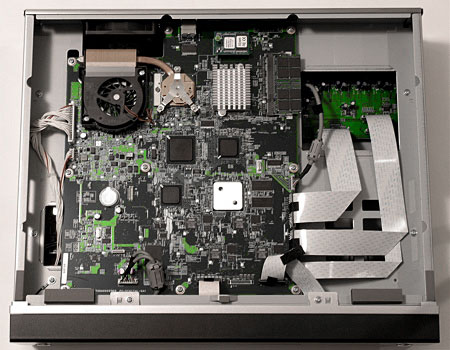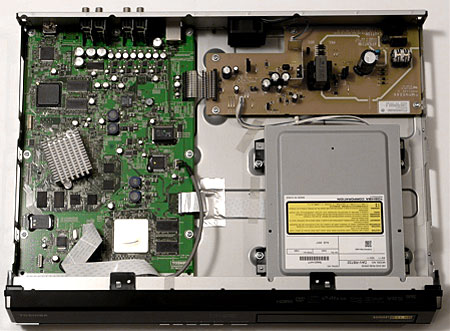Toshiba HD-A35 HD DVD Player
Why three generations in barely a year and a half? The answer is simple: a race to meet a price level that will insure the success of the format.

The $499 HD-A35 is the top of the line in this third generation, although the HD-XA2 still remains available for sale, at least while supplies last. Apart from Onkyo, which sells a player made by Toshiba, and Vantage, an as yet little known Chinese manufacturer, no other company markets HD DVD players.
Consumers sometimes judge quality by sheer mass. If it's big and heavy, it must be good. On that basis, the HD-A35, at a little over 2" high and 7.5 lbs soaking wet, looks a bit scrawny next to the "old" HD-XA1. Even the HD-A1, Toshiba's first "budget" player, weighed in at a fighting 16 lbs.
But sheer mass doesn't necessarily add that much to a disc player, as long as there's enough of it to stabilize the vibrations from the spinning disc. It often adds more to the cost than to the performance.
The original Toshiba players were brute force designs, which added to their bulk. The newest players are more refined, their software, processing chips, and circuitry more efficient. If their insides look skimpier (see Fig.1 and Fig.2 for shots of the insides of the original HD-A1 and HD-A35, respectively), their features and performance most definitely are not.

Fig.1 Toshiba HD-A1 First Generation Player. Note the large fan at the upper left. There's a second, smaller fan mounted vertically just behind it on the back panel. In addition to the large circuit board in the photo, there are additional boards underneath, one of which is just visible through the cutout at the upper right.

Fig.2 Toshiba HD-A35. The new player needs only a single small fan, mounted vertically on the center of the back panel. The only circuit boards are the ones visible here, though the large one at the left appears to be two-sided.
Round About
The player's clean front panel includes the usual power and play controls, though for full operation with most discs you'll need the remote. There's also a USB port under a small, drop down panel that Toshiba describes in the manual as simply "For future functions."
There are also bright front panel lights. A Dimmer button on the remote can reduce or shut off all but the blue light on the main power button. Though this light is smaller than the ring of blue that surrounded the power button on earlier Toshiba players, it still shines bright enough to be annoying in a darkened room. I covered it with a piece of tape—a crude but effective solution.
Things are busier around back, but there's nothing unusual there either. There's a jack for the (non-IEC) detachable power cord, an outlet for the ventilation fan (much quieter than in Toshiba's first generation machines but still a bit noisy) and the all-important Ethernet (LAN) port for downloading both firmware updates and Web-enabled disc features.
On the audio/video front, there are HDMI and component outputs, a digital audio output (TosLink only, unfortunately, many audiophiles would prefer a coaxial digital output), composite video (which seems pointless in a high def player, but can sometimes be useful for viewing on-screen menus in a crunch if, for example, you select a resolution not supported by your video display and the screen goes blank), and two-channel and 5.1-channel analog outputs.
The latter, along with bitstream output capability for next-gen audio codecs from Dolby and DTS, are the primary distinctions between this player and the less expensive, but also 1080p-capable Toshiba HD-A30.
Toshiba also specifies that the HDMI output can support up to 7.1-channels of discrete multichannel sound. And its HDMI 1.3 output also supports features such as xvYCC and Deep Color. We expect to see a few 7.1-channel soundtracks relatively soon, but on the color front we expect these enhancements to remain vaporware for a very long time.
The remote control, which will operate both the player and a TV, is the same remote that Toshiba used in its second-generation players. It's not backlit, and is smaller than the remote provided with the first generation players. But at least the button labels are now readable in dim lighting. (The early, non-backlit Toshiba HD DVD remotes used dark gray lettering on a black background, though the top-of-the-line player remotes offered backlighting.)
Apart from the lack of backlighting and the rather small buttons, the only complaint I have about the remote is the same one I had about earlier Toshiba HD DVD remotes. The forward chapter skip button is directly below the stop button. Since I tend to skip around on discs a lot when reviewing, it was all too easy to hit the Stop button by accident. And due to the way HD DVDs are authored, when you stop an HD DVD, you cannot resume play from that point; the disc must be started again from the beginning, which is a major nuisance. (The resume feature works with standard DVDs, however.)
The player is configured through the on-screen Setup menus, which may be accessed and changed only when the player is stopped. You cannot, for example, change the output resolution on the fly (a useful featured offered by Pioneer Blu-ray players).
- Log in or register to post comments




































































